U.S. Drought Highlights:
|
Contents Of This Report: |

 National Overview
National Overview
On the national scale,
|
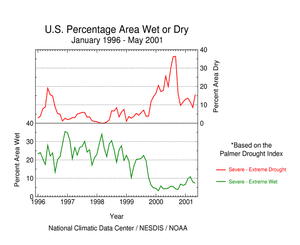 larger image |
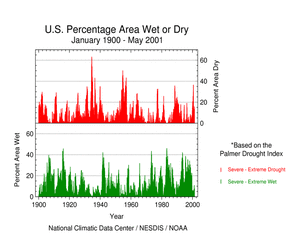 larger image |
Although some areas of the U.S. had well above normal precipitation, many areas were very dry. May averaged near normal when precipitation is integrated across the nation. Eleven of the last 22 months have averaged well below the normal, while only two averaged well above normal (see graph to right). National 2001 precipitation ranks:
|
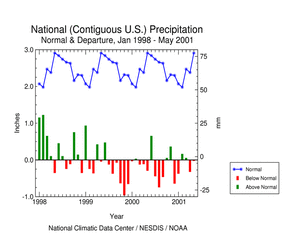 larger image |
During May 2001, dry conditions returned to the Pacific Northwest and West regions, with the northwestern quarter of the country, from Montana to Nevada and northern California, suffering from long-term drought. May was the second dry month in a row for the Northeast and Southeast regions, while May rains brought relief to much of the Central region. This pattern is evident in:
|

 Palmer Drought Indices
Palmer Drought Indices
| The Palmer Z Index shows how monthly moisture conditions depart from normal (short-term drought and wetness). May 2001 was severely dry across much of the country from Montana to Nevada, westward to the Pacific coast, across the Gulf coast and much of the Northeast, and over parts of Texas. Heavy rains brought drought relief to parts of the Ohio Valley. The animated maps to the right show the geographical pattern of the moisture anomalies for the last 12 months. On these maps, the red shading denotes dry conditions while the green shading indicates wet conditions. | 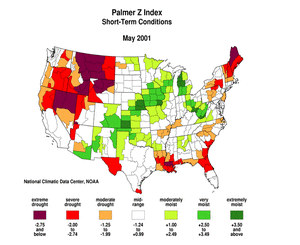 larger animated image |
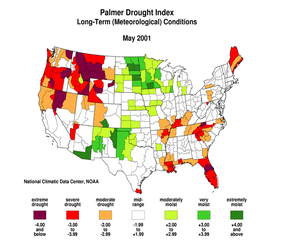 larger animated image |
The Palmer Drought Index maps show long-term (cumulative) meteorological drought and wet conditions. Long-term meteorological drought persisted across the Pacific Northwest, Gulf coast, and southern Appalachians, but decreased in intensity in the central Appalachians and in parts of the Ohio Valley and Northeast. The animated maps to the left show how the geographical pattern of the long-term (meteorological) moisture conditions has changed over the last 12 months. On these maps, the red shading denotes drought conditions while the green shading indicates wet conditions. |
| The Palmer Hydrological Drought Index maps show hydrological (long-term cumulative) drought and wet conditions, which more accurately reflect groundwater conditions, reservoir levels, etc. The PHDI indicates that hydrological drought persisted through the end of May across the Pacific Northwest states, northern and central Rockies, the Gulf Coast states, southern Appalachians, parts of the Ohio Valley, and over Maine and parts of Texas. The animated maps to the right show the geographical pattern of the long-term (hydrological) moisture anomalies for the last 12 months. On these maps, the red shading denotes dry conditions while the green shading indicates wet conditions. | 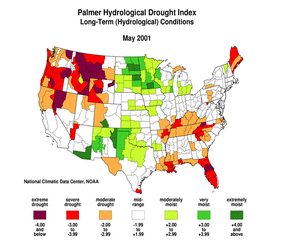 larger animated image |

 Regional Drought Watch:
Regional Drought Watch:
 Standardized Precipitation Index
Standardized Precipitation Index
| The Standardized Precipitation Index (SPI) is another way of measuring drought. The index is negative for drought, and positive for wet conditions. The SPI is a probability index that considers only precipitation, while Palmer's indices, shown in the previous maps, are water balance indices that consider water supply (precipitation), demand (evapotranspiration) and loss (runoff).
The seven maps below show the May 2001 spatial patterns of SPI for seven different periods ranging from one month (short-term conditions) to 24 months (long-term conditions). When taken together, they give a combined geographical and temporal picture of the severity of precipitation anomalies. The maps illustrate, for example:
|
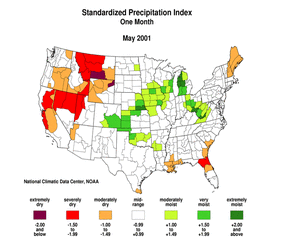 larger image |
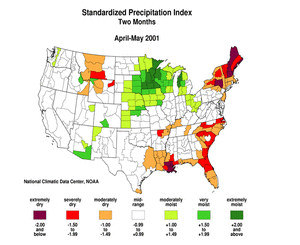 larger image |
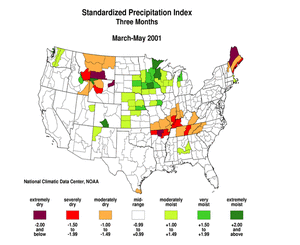 larger image |
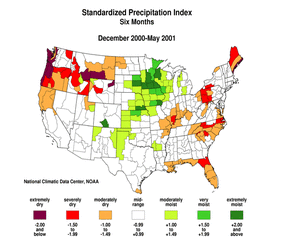 larger image |
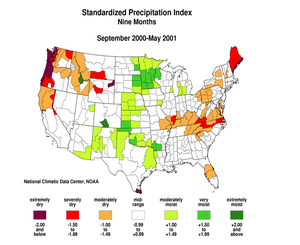 larger image |
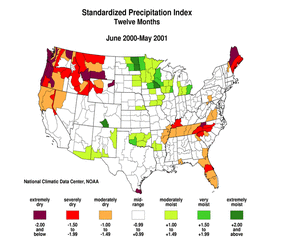 larger image |
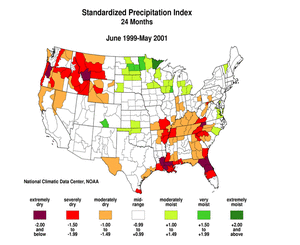 larger image |
 Regional Overview
Regional Overview
| The following table shows the precipitation ranks for the nine standard U.S. regions for May 2001, the three-month period March-May 2001, and the twelve-month period June 2000-May 2001. A rank of 1 is driest and 107 (106 for June-May) is wettest.
|
| The map to the bottom left shows the departure from normal of the number of days with measurable precipitation for May 2001. The short-term dryness in the Northwest and parts of Florida, Alaska, and the Northeast shows up on this map as significant below-normal (brown) number of precipitation days. The above-normal precipitation along the Alaskan panhandle and from the upper Mississippi Valley to the central Appalachians is reflected in a preponderance of above-normal rain days.
The spring (March-May) departure from normal number of days with measureable precipitation is shown in the map to the bottom right. A similar wet/dry pattern is evident in Alaska with predominantly dry conditions in the Hawaiian stations. A below-normal number of rain days can be seen in the Northeast and from the northern Rockies to intermountain basin in the West. A mixed pattern appears from the Ohio Valley to the Gulf coast. |
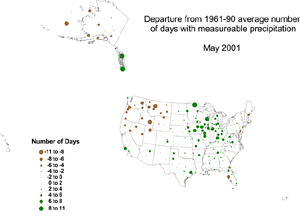 larger image |
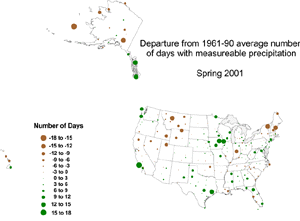 larger image |
 Western U.S. Drought
Western U.S. Drought
May brought a return to drier-than-normal conditions over much of the Pacific Northwest after a wetter-than-normal April (see graph below left). Ranks for 2001:
|
|
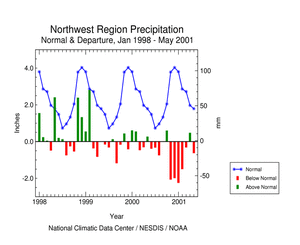 larger image |
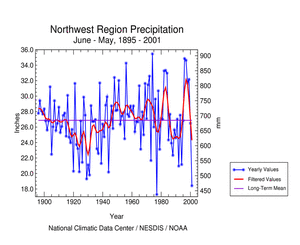 larger image |
| Montana had the fifth driest May and third driest December-May on record in 2001. The dry conditions have contributed to falling well levels and to the development of scattered wildfires in parts of Montana and Idaho. |
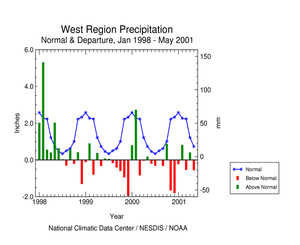 larger image |
The West region (California and Nevada) had the fifth driest May in 2001. The effects from the lack of rain were compounded by higher than normal evaporation as the region experienced its hottest May in the 107-year record. Additional ranks for this year's rainy season:
|
 Southeast and Southern Plains Drought
Southeast and Southern Plains Drought
The Southeast region has experienced dry conditions over much of the last four years (since May 1998, see graph below left). Although some parts of the region have seen recent drought relief, long-term drought continued region-wide. May 2001 marked the second dry month in a row, following an unusually wet March. For the Southeast region,
|
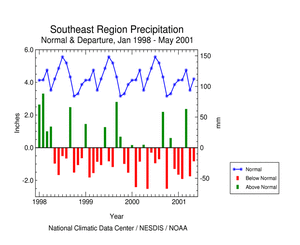 larger image |
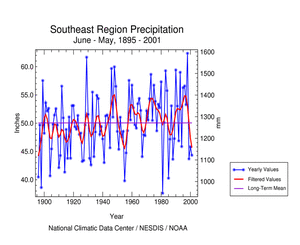 larger image |
Very dry conditions continued in Florida during May. Highlights in the state include:
|
| The South region had the 42nd wettest May on record in 2001. However, parts of the southern Plains continued in prolonged drought. Western and southern Texas were in the moderate to severe drought category by the end of May. |
 Northeast Region Dryness
Northeast Region Dryness
Much of the Northeast region experienced the second dry month in a row during May 2001 (see graph below left):
|
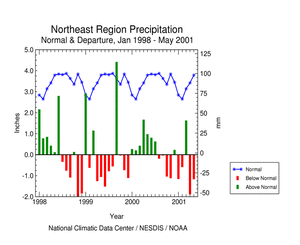 larger image |
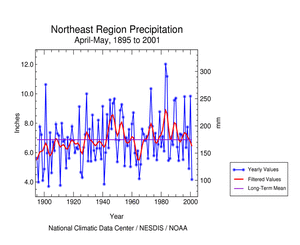 larger image |

 Additional Contacts:
Additional Contacts:
| Damage due to the drought has been summarized by NOAA and the Office of Global Programs in the Climatological Impacts section of the Climate Information Project. Crop impact information can be found at the USDA NASS (National Agricultural Statistics Service) and Weekly Weather and Crop Bulletin pages. Drought statements by local National Weather Service Offices can be found at the NWS Hydrologic Information Center. Drought threat assessments and other information can be found at NOAA's Drought Information Center. Additional drought information can be found at the National Drought Mitigation Center, the USDA's National Agricultural Library, the interim National Drought Council, and the NOAA Paleoclimatology Program. The following states have set up web pages detailing their plans to handle drought emergencies:
New Mexico - North Carolina - Oklahoma - South Carolina - Texas - Washington For additional information on the 2001 wildfire season please see the National Interagency Fire Center web site or the U.S. Forest Service Fire and Aviation web site. Additional climate monitoring graphics can be found at the Climate Prediction Center's monitoring pages: |
 NOAA's National Centers for Environmental Information
NOAA's National Centers for Environmental Information